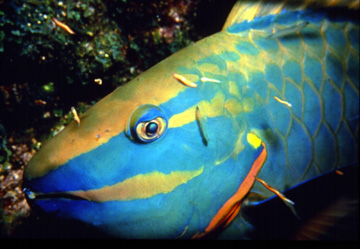If you camp out on a tropical island, it’s a good idea to have some mosquito netting to keep the little bloodsuckers at bay while you sleep. And the same rule may apply to some parrotfish that sleep on tropical coral reefs. The fish make their own netting, which appears to keep away the underwater equivalent of mosquitoes.
 Some species of parrotfish surround themselves in mucus cocoons. Credit: National Oceanic and Atmospheric Administration.
Some species of parrotfish surround themselves in mucus cocoons. Credit: National Oceanic and Atmospheric Administration.Before they nod off, some species of parrotfish surround themselves in a thick cocoon of mucus. It’s produced by glands near the gills, and it takes a half-hour or so to make.
Marine biologists have been debating the purpose of the cocoons for decades. An early study suggested it protected the fish from predators by masking the parrotfish’s scent, or by serving as an early warning system when it’s disturbed by the rustling of something close by.
A study in 2010 found another possible use for the cocoon: mosquito netting.
The parrotfish is often attacked by marine “gnats” -- tiny crustaceans that suck the fish’s blood. During the daytime, the parrotfish seeks out “cleaner” fish to remove the pests. When it’s sleeping, though, it has no such protection. But the study found that parrotfish surrounded by mucus cocoons were much less likely to be attacked by the gnats than fish with no cocoons. And it only takes a small amount of energy to make the cocoon, so it’s a pretty efficient means of protection.
That doesn’t mean that mosquito netting is the only reason for the cocoons. But it does mean the fish can sleep a little more comfortably on those tropical camp-outs.

